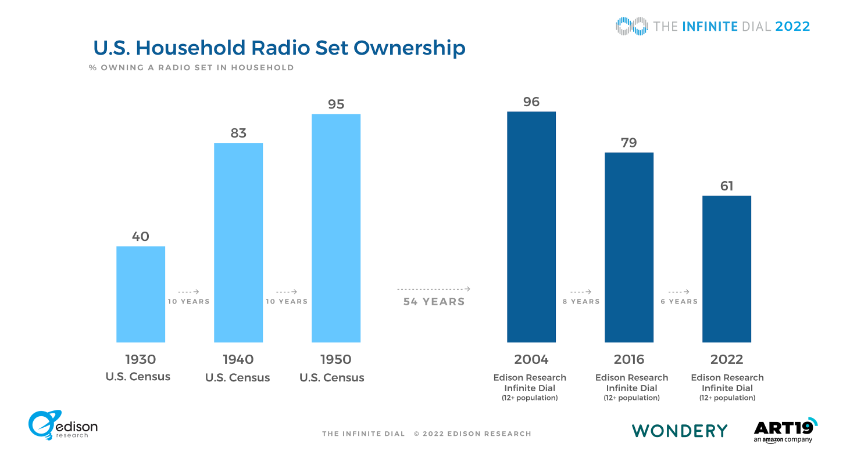
(By Larry Rosin) At the RAIN Conference before the 2018 NAB Radio Show, my colleague Megan Lazovick gave an extremely compelling talk entitled “Radio’s Hardware Problem: How does radio compete if consumers don’t have a radio?” You can find her talk in written form here — seriously, read it. Pretty much everything she said matters as much or more today.
It is probably meaningful to consider that both the RAIN Conference at the NAB Radio Show are no longer. While there is a pandemic to blame in part, it does say something about how much things have changed in the intervening four years.
But the ‘hardware crisis’ that Megan pointed the industry to in 2018 has only accelerated. Earlier this year we reported in the 2022 Infinite Dial, brought to you in partnership with Wondery and Art19, that now 61% of Americans report having at least one single-use, traditional ‘radio’ in their houses or apartments (excluding those in their cars).

Meanwhile, I recently read the terrific new book, “Democracy’s Data,” about the history of the U.S. Census, and only then learned that there was a period of time when the decennial census was also tracking ownership of a radio in the home. In 1930, the question was first asked, and the bureau reported that 40% of American households had acquired a ‘radio set’ by this date. Ten years later, the 1940 Census reported that the number had swelled to about 83% of households.
Bear in mind, these are percentages off a much smaller population, so the raw number of households with radios today dwarfs the number from 1940. However, in terms of percentage, it seems in-home radio ownership has dropped to a level something like that of 1935.
It’s a little daunting to contemplate that these questions were once deemed important enough to be on the U.S. Census and now are being tracked, exclusively as far as I can tell, by Edison Research.
Regardless, it is clear that in-home ownership of the radio device is dropping, as they are rapidly being replaced by internet-connected devices. And even that bastion of the radio— the car — is now seeing some small decline in radios, especially AM in electric vehicles, but in select cases even FM is now an option (as opposed to standard).
I have maintained for years that the abandonment of hardware is a problem, if not a crisis, for the American “Radio” industry. Merely having a radio set is the first step to listening to the radio. If we were to run a test where we put a radio into every single room of someone’s house, I can virtually guarantee that radio listening in that house would rise.
In fact, data from Nielsen in PPM markets essentially proves this point. Below is a table showing the relationship between owning a radio and listening to the radio:
Number of radios Average Quarter-Hours
In household per day
0 2.8
1 3.6
2 4.1
3 4.6
4 5.1
5+ 5.2
Data: Nielsen
Now, you may choose to see this as the opposite of what I averred above — that people who are interested in listening to more radio keep more radios in their home. But the mere availability of these devices has to be driving the correlation we see here.
Of course, American radio companies have done a decent-enough job of making their content available on digital devices via streaming, although in some cases kicking and screaming along the way. However, as many listeners to streamed radio continue to report, the experience is often clunky at best: I was recently listening to a stream of an out-of-market radio station and heard the same ad three times in a single break. The fact that I’m older than the ‘sales demo’ probably explains the lack of targeted ads, but do I really need to learn what the “best holster for concealed carry” is three times in one break?
Per our data and matched by Nielsen data, about 12% of radio stations’ listening now comes from the streams, a portion that has grown generously over the last decade. But any growth in radio-station streaming is more than offset by declines in listening through a ‘radio set’.
In the years that Edison Research has been sounding the alarm about radio’s ‘hardware problem’ we have encountered regular pushback. I have had several thoughtful radio leaders argue that the advent of streaming and devices like smartphones and smart speakers means that the decline in radio-set ownership is being offset, and thus there is no ‘problem’.
And yet, pretty much everyone agrees that cars not having a radio tuner in them is a problem. So the in-home issue perhaps really is the warning shot.
Ultimately, the American radio industry grew to prominence as a software provider for a hardware platform that is now in decline. Radio sets were a protected ‘walled-garden’ environment with a limited number of options available. There is a reason we dubbed the new audio environment an “Infinite Dial” so many years ago. How well you think ‘radio’ has competed and can compete on this Infinite Dial will determine how much of a concern radio’s “hardware problem” really is.
Larry Rosin is President of Edison Research, which he co-founded in 1994. He can be reached by at [email protected]






What a fantastic post! The writer clearly did their research and presented the information in a clear and concise manner. I will definitely be sharing this with my friends and family.
What a fantastic post! The writer clearly did their research and presented the information in a clear and concise manner. I will definitely be sharing this with my friends and family.